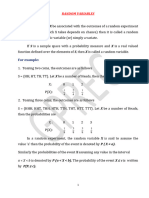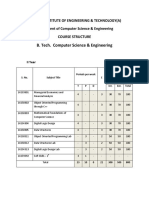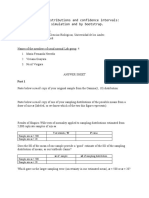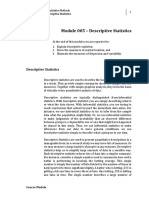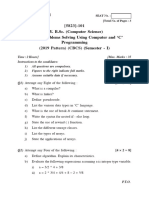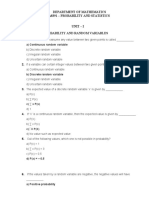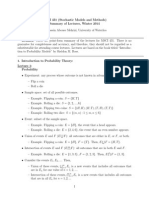CHAPTER 3: DISCRETE RANDOM VARIABLE AND 0 𝑥<1
PROBABILITY DISTRIBUTIONS 7. 𝐹(𝑥) = {0.5 1≤𝑥<3
1 3≤𝑥
a. 𝑃(𝑋 ≤ 3) c. 𝑃(1 ≤ 𝑋 ≤ 2)
Probability Distributions and Probability Mass
b. 𝑃(𝑋 ≤ 2) d. 𝑃(𝑋 > 2)
Functions
For discrete random variable X with possible values
8. Errors in an experimental transmission channel are
𝑥1 , 𝑥2 , . . . . . 𝑥𝑛 a probability mass function is a
found when the transmission is checked by a
function such that
certifier that detects missing pulses. The number of
(1) 𝒇(𝒙𝟏 ) ≥ 𝟎
errors found in an eight-bit byte is a random
(2) ∑𝒏𝒊=𝟏 𝒇(𝒙𝟏 ) = 𝟏
variable with the following distribution:
(3) 𝒇(𝒙𝟏 ) = 𝑷(𝑿 = 𝒙𝟏 )
0 𝑥<1
0.7 1≤𝑥<4
Example: 𝐹 (𝑥 ) = {0.9 4≤𝑥<7
1. The sample space of a random experiment is {a, b, 1 7≤𝑥
c, d, e, f}, and each outcome is equally likely. A Determine each of the following probabilities:
random variable is defined as follows: a. 𝑃(𝑋 ≤ 4) d. 𝑃(𝑃(𝑋 > 4)
outcome a b c d e F b. 𝑃(𝑋 > 7) e. 𝑃(𝑋 ≤ 2)
x 0 0 1.5 1.5 2 3 c. 𝑃(𝑃 ≤ 5)
Determine the probability mass function of X.
2. Use the probability mass function in Exercise 1 to MEAN AND VARIANCE OF A DISCRETE RANDOM
determine the following probabilities: VARIABLE
a. 𝑃(𝑋 = 1.5) d. 𝑃(0 ≤ 𝑋 < 2) The mean and expected value of the discrete
b. 𝑃(0.5 < 𝑋 < 2.7) e. 𝑃(𝑋 = 0 𝑜𝑟 𝑋 = 2) random variable 𝑋, denoted as 𝜇 or 𝐸(𝑋), is
c. 𝑃(𝑋 > 3)
𝝁 = 𝑬(𝑿) = ∑ 𝒙𝒇(𝒙)
𝒙 −2 −1 0 1 2 𝒙
3. The variance of 𝑋, denoted as 𝜎 2 or 𝑉(𝑋), is
𝒇(𝒙) 1/8 2/8 2/8 2/8 1/8
a. 𝑃(𝑥 ≤ 2) c. 𝑃(−1 ≤ 𝑥 ≤ 1) 𝝈𝟐 = 𝑽(𝑿) = 𝑬(𝑿 − 𝝁)𝟐 = ∑(𝒙 − 𝝁)𝟐 𝒇(𝒙) =
b. 𝑃(𝑥 > −2) d. 𝑃(𝑥 ≤ 1 𝑜𝑟 𝑥 > 1) 𝒙
∑ 𝒙𝟐 𝒇(𝒙) − 𝝁𝟐
8 1 𝑥
4. 𝑓(𝑥) = (7) (2) , 𝑥 = 1, 2, 3 𝒙
a. 𝑃(𝑥 ≤ 1) c. 𝑃(2 < 𝑥 < 6) The standard deviation of 𝑋 is a 𝝈 = √𝝈𝟐
b. 𝑃(𝑥 > 1) d. 𝑃(𝑥 ≤ 1 𝑜𝑟 𝑥 > 1) 9. If the range of X is the set {0, 1, 2, 3, 4} and
𝑃(𝑋 = 𝑥) = 0.2 determine the mean and variance
CUMULATIVE DISTRIBUTION FUNCTIONS of the random variable.
The cumulative distribution function of a 10. Determine the mean and variance of the random
discrete random variable 𝑋, denoted as 𝐹(𝑥), is variable in Exercise #1
11. Determine the mean and variance of the random
𝐹(𝑥) = 𝑃(𝑋 ≤ 𝑥) = ∑ 𝑓(𝑥𝑖 )
variable in Exercise #3.
𝑥𝑖 ≤1
For a discrete random variable 𝑋, 𝐹(𝑥) satisfies the 12. Determine the mean and variance of the random
2𝑥+1
following properties. variable in (𝑥) = , 𝑥 = 0, 1, 2, 3, 4
25
• 𝑭(𝒙) = 𝑷(𝑿 ≤ 𝒙) = ∑𝒙𝒊≤𝟏 𝒇(𝒙𝒊 )|
• 𝟎 ≤ 𝑭(𝒙) ≤ 𝟏 DISCRETE UNIFORM DISTRIBUTION
• 𝑰𝒇 𝒙 ≤ 𝒚, 𝒕𝒉𝒆𝒏 𝑭(𝒙) ≤ 𝑭(𝒚) A random variable 𝑋 has a discrete uniform
5. Determine the cumulative distribution function of distribution if each of the 𝑛 values in its range, say,
the random variable in Exercise #1. 𝑥1 , 𝑥2 , . . . . . , 𝑥𝑛 has equal probability. Then,
6. Determine the cumulative distribution function for 𝒇(𝒙𝒊 ) = 𝟏/𝒏
the random variable in Exercise #3; also determine
the following probabilities: Suppose 𝑋 is a discrete uniform random variable on the
a. 𝑃(𝑋 ≤ 1.25) c. 𝑃(−1.1 < 𝑋 ≤ 1) consecutive integers 𝑎, 𝑎 + 1, 𝑎 + 2, . . . . , 𝑏, for 𝑎 ≤ 𝑏.
b. 𝑃(𝑋 ≤ 3) d. 𝑃(𝑋 > 0) The mean of 𝑋 is
𝑏+𝑎
𝜇 = 𝐸(𝑋) =
2
� 19. Determine the cumulative distribution function of
The variance of 𝑋 is a binomial random variable with 𝑛 = 3 and 𝑝 =
1/2.
(𝑏 − 𝑎 + 1)2 − 1 20. An electronic product contains 40 integrated
𝜎2 =
12 circuits. The probability that any integrated circuit
is defective is 0.01, and the integrated circuits are
13. Let the random variable X have a discrete uniform independent. The product operates only if there
distribution on the integers 0 ≤ 𝑥 ≤ 100 . are no defective integrated circuits. What is the
Determine the mean and variance of X. probability that the product operates?
14. Let the random variable X have a discrete uniform 21. Determine the cumulative distribution function of
distribution on the integers 1 ≤ 𝑥 ≤ 3. Determine a binomial random variable with 𝑛 = 3 and 𝑝 =
the mean and variance of X. 1/4.
15. Let the random variable X be equally likely to 22. Let 𝑋 denote the number of bits received in error
assume any of the values 1/8, 1/4, or 3/8. in a digital communication channel, and assume
Determine the mean and variance of X. that 𝑋 is a binomial random variable with 𝑝 =
16. Thickness measurements of a coating process are 0.001. if 1000 bits are transmitted, determine the
made to the nearest hundredth of a millimeter. following:
The thickness measurements are uniformly a. 𝑃(𝑋 = 1)
distributed with values 0.15, 0.16, 0.17, 0.18, and b. 𝑃(𝑋 ≥ 1)
0.19. Determine the mean and variance of the c. 𝑃(𝑋 ≤ 2)
coating thickness for this process. d. 𝑚𝑒𝑎𝑛 𝑎𝑛𝑑 𝑣𝑎𝑟𝑖𝑎𝑛𝑐𝑒 𝑜𝑓 𝑋
BINOMIAL DISTRIBUTION
A random experiment consists of n Bernoulli trials such
that
1. The trials are independent
2. Each trial results in only two possible
outcomes, labeled as “success’’ and “failure’’
3. The probability of a success in each trial,
denoted as 𝑝, remains constant
The random variable X that equals the number of trials
that result in a success has a binomial random variable
with parameters 0 < 𝑝 < 1 and 𝑛 = 1, 2, . . .. . The
probability mass function of X is
𝒏
𝒇(𝒙) = ( ) 𝒑𝒙 (𝟏 − 𝒑)𝒏−𝒙 𝒙 = 𝟎, 𝟏, . . . . 𝒏
𝒙
If 𝑋 is a binomial random variable with parameters
𝑝 and 𝑛
𝝁 = 𝑬(𝑿) = 𝒏𝒑 𝒂𝒏𝒅 𝝈𝟐 = 𝑽(𝑿)𝒏𝒑(𝟏 − 𝒑)
17. The random variable X has a binomial distribution
with 𝑛 = 10 and 𝑝 = 0.5. Determine the following
probabilities:
a. 𝑃(𝑋 = 5) c. 𝑃(𝑋 ≥ 9)
b. 𝑃(𝑋 ≤ 2) d. 𝑃(3 ≤ 𝑋 < 5)
18. The random variable X has a binomial distribution
with 𝑛 = 10 and 𝑝 = 0.01. Determine the
following probabilities.
a. 𝑃(𝑋 = 5) c. 𝑃(𝑋 ≥ 9)
b. (𝑋 ≤ 2) d. 𝑃(3 ≤ 𝑋 < 5)

















































